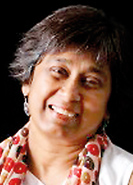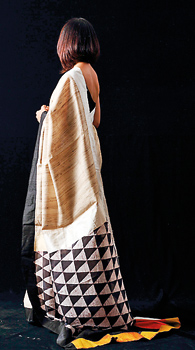Joyous drapes
Nelun Harasgama designs her sarees downstairs while her husband, the photographer Luxshman Nadaraja takes pictures of them upstairs. “He is famous, I am not,” says Nelun, smiling, but that isn’t quite true. Before she ever began designing sarees, Nelun’s paintings won her acclaim but she always found them difficult to talk about. Stark and haunting, the images were often leached of colour and explored weighted themes awash with violence, grief and isolation. Designing sarees (and shawls, cushion covers and upholstery) couldn’t be a more different experience – the word Nelun uses more than once to describe it is “joyous.”

Nelun: Focusing on the wearer
Today, she has a saree draped over her dining table. Her assistant Lena sits sewing circles of bright yellow and orange onto the fabric under her direction. Around us, is the house Nelun has lived in for 15 years – only during the last two has it doubled as the Ohe Island store.
The saree she is working on is a batik design placed on a base of raw silk. Nelun eschews the soft, satiny fabrics which she considers too shiny for this thicker, more textured material. She designs each piece and works closely with a batik artist in Kandy. Then she brings it home and begins her experiments in patchwork.
The blue and black creation she’s currently working on is inspired by the Spanish painter Joan Miró. She says her sarees are often inspired by other artists and that in a sense it is her interpretation of their work that determines the palette and the design.
“I take the colours and the proportion of the colours,” she says, pointing to an image where the actress Kaushalya Fernando wears a piece inspired by the Rembrandt’s Night Watch. The resemblance is in the colours – the balance of orange and black. (Where Nelun avoided black in her paintings, she loves the elegance of the colour in raw silk. Her sarees have liberated her palette so that she works with a range of colours.) Nelun’s intention is to convey the essence, the feeling the painting evokes.

In her mind she imagines a friend wearing it – this friend is the Georgia O’ Keeffe, another should wear a Vincent Van Gogh. “Whoever wears the sarees, you can see their character. They all look like themselves,” she says, telling me that all her models are friends who “come and dance around upstairs.” The images Laxshman produces are wonderful but they serve Nelun in that the focus is on the wearer. “I don’t want them to look at the saree. I want them to look at the person.”
By incorporating patchwork into her unusual designs, Nelun is also reinventing batik for the modern market. “I think batik has this old-fashioned idea behind it but I think with batik you can do anything,” she says. “You don’t have to use the same traditional motifs, though they are beautiful too.”
Her sarees have many seams, not just from the patchwork but along the boundaries where different kinds of fabrics meet. She has a fondness for using translucent sections along the fall, allowing the colour underneath to shimmer through and creating another layer to the design. In her batik inspired shawls she employs the same technique, melding lush velvets and thick silks with lighter fabrics.
She works purely by instinct – experience has taught her how much fabric to set aside for her fall. When it comes to her designs, her hand knows how to taper them and arrange the proportions so that it looks its best when draped. The last may have been a skill honed by her studies in graphic design in Nottingham.
(Her parents, who wanted to ensure that she could earn a living steered her away from pursuing a degree in fine arts.) A fan of all things handmade, she worked at Barefoot for a while before opting to stay home when her daughter Arranga was born. “Now she is 13, I was ready to get back and I wanted to do something I hadn’t seen before,” she says. “I thought patchwork would be fun. It’s not like painting. Painting is very depressing.”
It’s quite likely telling that none of the dozen or so paintings hanging on her living rooms walls are her own. She points out one – an extravagant splash of red on a yellowing newspaper – that is the work of five-year-old Arranga. Nelun says she’s happy to keep her business small and running out of home.This way she can also hire people from the area and pay them a good wage. If she were to imagine a future for it, she would wish her child to take an interest. Already, mother and daughter work on the patchwork cushions together, tailoring them out of the scraps left over from the sarees. It seems but one small step from here to designing a saree together.
comments powered by Disqus

